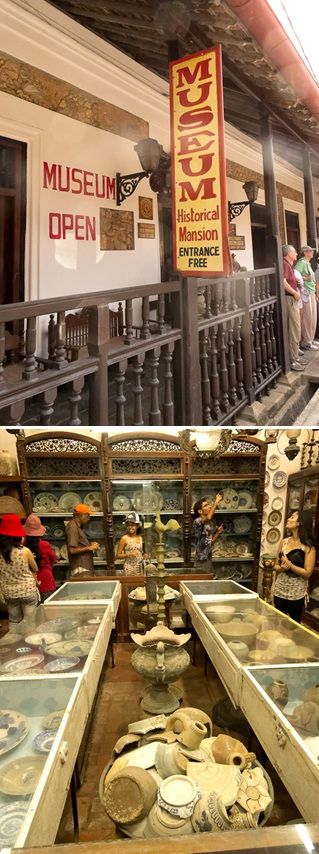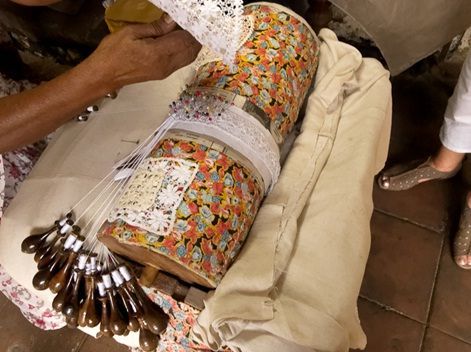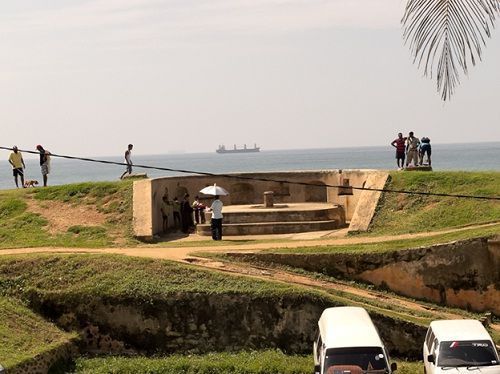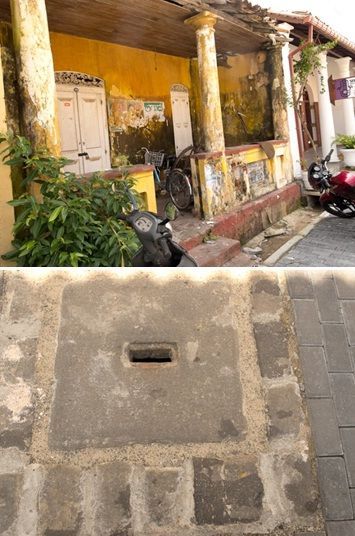Article
Historical Preservation in Galle, Sri Lanka
Author(s):
Old Galle is the best preserved colonial town in Sri Lanka and its history is complex; however, few Americans get to it because Sri Lanka is so far.
“If I lived here, I think I would die”
- A visitor referring to the heat
There are few places in the world where a museum sells what it exhibits. Galle, however, can claim that distinction. Mansion Museum within the fort in old Galle, Sri Lanka shows what it sells and sells what it shows (almost everything). The items that are not for sale are marked as such.

(Top) The "museum," label is a misnomer. (Bottom) Visitors enjoy the museum contents, which are also merchandise for sale.
The museum is the brainchild of Abdul Gaffar, who collected widely, and exhibits what some might call junk and others treasure. Whatever the case, people were buying. They may have been enticed by the demonstrations within the museum of embroidery, silver working and gem craft. One guidebook suggests that the main reason for the existence of the “museum” is to draw in potential customers.

A live embroidery demonstration is an attraction within the Mansion Museum.
Old Galle is the best preserved colonial town in Sri Lanka and its history is complex. The Portuguese were unwillingly foisted onto Galle in 1505 when they were forced into its port by a storm that diverted them from the Maldives. They didn’t stay, possibly too discouraged by the hot weather.
However, in 1587 they came back, this time thinking to tap into the prosperous spice trade. They formed roots by building a fort they called Santa Cruz. Then the Dutch took Galle from the Portuguese in 1640. The red-haired devils (an early Chinese term for the Dutch that was not endearing) added garrison additions. Finally, the British seized power, but in a peaceable way, after the Dutch capitulated in the Napoleonic War.
All of these colonial invasions left Galle a large and pleasant, though still toasty, fort. Today it is a UNESCO heritage site.

The fort is well preserved today.
Not too far from the Mansion Museum is Barefoot, a shop that sells just about everything: fabric, tablecloths, stationery and more. It provides a more secure use of money and would be especially good for small gifts. I saw several trays of lovely necklaces perfect for that purpose.

(Top) The shop, Barefoot, and (bottom) a restored colonial home.
In between the two are mostly well-renovated colonial houses in bright colors. Occasionally though, there is a derelict structure still waiting for loving care. The street is especially interesting as it contains drains for rainwater, part of the Dutch system for modern day toilets. The tide would come in under the streets and washed out the sewage.

(Top) A derelict building and (bottom) an early Dutch drain to catch rainwater.
The National Maritime Museum is also included within the fort perimeter, as well as several historic churches and a mosque. Though outside of the fort, Koggala is another attraction in the area. It is a museum of folk art that honors a well-known Sri Lankan writer, Martin Wickramasinghe.
All in all, Galle is an out-of-the-way place that attracts mostly visitors from the European and Asian continents. This important historical site is tucked into an exotic part of the world that few Americans get to. Those who do venture there, however, will surely be pleasantly surprised by its rich history, as well as the high level of preservation of attractions from its past.
Some specifics:
Fly into Colombo and drive (or hire a driver) to Galle. Also, some ships stop at Galle as it is directly on the water.
How to get there:
Even when the weather is cool for the area, it is hot for Americans. Plan on being out in the cooler parts of the day, wear sunscreen and, if desired, use a small battery operated fan.
Caution:
: Two days is the minimum for the area. For some people, this would definitely be enough as Galle is not as sophisticated like some other tourist attractions.
Total Time
Read more:
The Temple of the Tooth: A UNESCO Heritage Site




